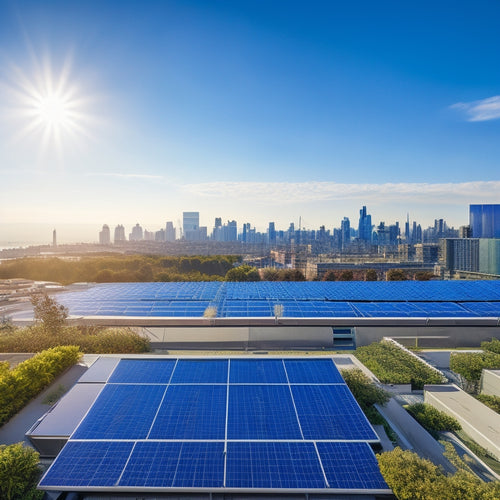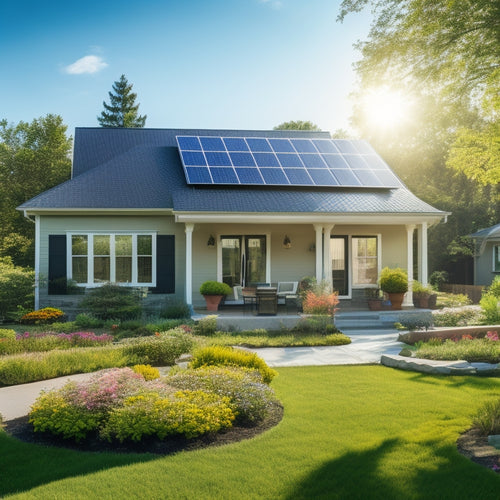
What Do Commercial Solar Installations Cost in California?
Share
Your commercial solar installation cost in California will likely range from $2.50 to $3.50 per watt, with the total project cost dependent on factors such as system size, installation complexity, and the type of panels used. System size, for instance, plays a significant role in determining overall expenses, as larger systems can achieve lower costs per watt due to economies of scale. As you explore your options, you'll want to take into account the average cost per watt, federal and state incentives, and other key factors that can impact your bottom line - and there's more to discover.
Key Takeaways
• Commercial solar panel costs in California range from $2.50 to $3.50 per watt, depending on system size and installation complexity.
• Larger systems achieve lower costs per watt due to economies of scale, with industrial sector installations over 1 megawatt potentially increasing costs.
• Federal and state incentives, such as the Solar Investment Tax Credit and CSI Thermal Program, can reduce upfront expenditures and drive down costs.
• The average cost of a commercial solar panel system in California is between $250,000 and $350,000 for a standard 100-kilowatt system.
• System costs vary based on factors including panel quality, manufacturer, and installation process, with prices fluctuating based on system size, complexity, and efficiency.
Commercial Solar Panel Costs California
When contemplating commercial solar installations in California, you'll likely be quoted a total project cost that includes the cost of the solar panels, which typically ranges from $2.50 to $3.50 per watt, depending on the quality of the equipment and the complexity of the installation.
This cost per watt is a key factor in determining the overall expense of your solar project. California's Solar Policy has created a favorable environment for businesses to adopt green technology, driving down costs and increasing adoption.
System Size and Cost Factors
When exploring commercial solar installations in California, the size of the system becomes a critical factor in determining costs.
You'll need to evaluate the size of your system, measured in kilowatts (kW), and how it influences your overall expense.
System Size Variations
You can expect the cost of a commercial solar installation in California to fluctuate considerably depending on the system size, with larger systems typically achieving lower costs per watt. As you consider your solar installation, keep in mind that system size variations will impact your overall cost.
Larger systems, often used for commercial properties, can take advantage of economies of scale, reducing the cost per watt. This is particularly important for businesses looking to maximize their energy efficiency and reduce their carbon footprint through solar landscaping. By choosing a larger system, you can increase your energy efficiency while also reducing your costs.
It's crucial to assess your energy needs and determine the best system size to achieve your goals.
Cost Factor Breakdown
Your commercial solar installation's cost in California is influenced by several factors, including system size, equipment quality, installation complexity, and local labor costs. All of these must be carefully considered to achieve maximum energy efficiency and cost savings.
To develop effective budgeting strategies, you'll need to understand how each of these factors impacts your overall cost. For instance, larger systems require more equipment, increasing upfront costs, while high-quality equipment may be more expensive but provide better long-term performance.
Installation complexity, such as rooftop vs. ground-mounted systems, also affects labor costs. By carefully evaluating these factors, you can create accurate financial projections and optimize your solar installation's cost-effectiveness.
Installation Costs by Sector
When exploring the costs of commercial solar installations in California, it's crucial to take into account the varying installation costs across different sectors.
You'll find that industrial sector costs differ from commercial property prices, and agricultural sector rates have their own unique characteristics.
Let's examine each sector's costs to grasp the specific factors influencing the installation prices.
Industrial Sector Costs
Industrial sector clients in California typically require larger commercial solar installations, often exceeding 1 megawatt in capacity, which drives up installation costs. As an industrial client, you're likely aiming to maximize energy efficiency and reduce your energy expenditure.
You'll want to explore the latest industrial trends in solar energy, such as the use of high-efficiency panels and advanced inverters. These upgrades can increase your system's energy output, but they also come at a higher cost.
On average, industrial-scale solar installations in California can cost between $2.50 and $3.50 per watt, depending on the system size and complexity. By investing in a high-quality solar installation, you can enjoy significant energy savings and a quicker return on investment.
Commercial Property Prices
Commercial property owners seeking to harness solar energy in California can expect installation costs to vary considerably depending on the type and size of their property, with prices ranging from $2.75 to $4.25 per watt for rooftop installations and $2.25 to $3.75 per watt for carport and ground-mount systems.
| Property Type | Installation Cost (per watt) | Zoning Laws and Property Taxes |
|---|---|---|
| Office Buildings | $2.75 - $3.50 | Varies by city, affects property taxes |
| Retail Stores | $2.50 - $3.25 | Zoning laws may impact installation design |
| Restaurants | $2.75 - $3.50 | Property taxes may increase with installation |
| Hotels | $2.25 - $3.00 | Zoning laws may impact installation design |
| Warehouses | $2.50 - $3.25 | Property taxes may increase with installation |
Keep in mind that zoning laws and property taxes can impact your installation costs and overall return on investment.
Agricultural Sector Rates
In the agricultural sector, you can expect to pay between $2.25 and $3.50 per watt for solar installations, with costs varying depending on factors like farm size, crop type, and irrigation systems.
As an agricultural business owner, you're likely concerned about the impact of solar installations on your Farm Insurance premiums. Fortunately, many insurance providers offer specialized policies that cover solar installations, ensuring you're protected in case of damage or malfunction.
Additionally, solar installations can increase Crop Yields by providing shade, reducing water evaporation, and creating a more favorable microclimate. By investing in solar, you can boost your agricultural productivity while reducing your energy costs.
With the right installation, you can reap the benefits of renewable energy while maintaining a profitable and sustainable agricultural operation.
Average Cost per Watt California
On average, you can expect to pay around $2.50 to $3.50 per watt for a commercial solar installation in California, with the overall cost varying depending on the system size and installation company. This cost per watt can fluctuate due to factors such as the complexity of the installation, local building codes, and the type of equipment used.
California legislation has created a favorable environment for renewable energy, driving down costs through initiatives like Watt auctions, which have helped reduce the cost of solar energy. As you navigate the process of installing commercial solar panels, understanding the average cost per watt will help you make informed decisions about your investment.
Keep in mind that prices can vary depending on your specific project requirements and the installation company you choose.
Federal and State Incentives
As you explore the costs associated with commercial solar installations in California, you'll find that federal and state incentives can greatly reduce your upfront expenditures.
The Solar Investment Tax Credit (ITC) is a key federal incentive, allowing you to claim a tax credit of 26% of the total project cost. Additionally, California offers various state incentives, including the California Solar Initiative (CSI) Thermal Program, which provides rebates for commercial solar thermal systems.
You may also be eligible for incentives from your utility company or local government. By taking advantage of these incentive programs, you can markedly reduce the cost of your commercial solar installation. Be sure to research and explore all available options to maximize your savings.
Commercial Solar Panel Prices
When you're considering a commercial solar installation in California, you'll want to understand the costs associated with the solar panels themselves. The prices of commercial solar panels vary depending on the system size, quality, and manufacturer.
You'll need to factor in the costs of the panels, which can range from $2.50 to $3.50 per watt, depending on the specific requirements of your project.
System Costs
You can anticipate paying between $2.50 and $3.50 per watt for commercial solar panel systems in California, with the total cost varying depending on the system size and installation complexity. This translates to a total system cost ranging from $250,000 to $350,000 for a standard 100-kilowatt system.
When exploring solar financing options, it's crucial to take into account the overall energy efficiency of your system. By investing in high-quality equipment and optimizing your system's design, you can maximize your energy output and reduce your payback period.
With the right financing strategy and system design, you can realize significant savings and boost your bottom line. By prioritizing energy efficiency, you can make the most of your commercial solar installation and reap the rewards of going solar.
Average Prices
Commercial solar panel prices in California average between $2.50 and $3.50 per watt, with higher-efficiency panels typically costing more than their standard counterparts. As you explore the California solar market, you'll notice that prices can fluctuate based on market conditions and California benchmarks. Here are some key factors influencing commercial solar panel prices:
-
System size and complexity: Larger systems with more complex installations tend to cost more.
-
Panel efficiency and quality: High-efficiency panels with premium materials and warranties come at a higher cost.
-
Installation company and labor costs: Reputable installers with experienced labor forces may charge more for their services.
Keep in mind that these factors, along with market fluctuations, can impact the final cost of your commercial solar installation in California.
Installation Process and Timeline
The installation process for a commercial solar panel system in California typically unfolds over several stages, with a project timeline that can vary depending on the scope and complexity of the project.
As a business owner, you'll work closely with a project manager to oversee the installation process, ensuring it stays on track and meets your expectations.
The project management team will conduct a thorough site assessment to identify potential obstacles and optimize system design. This assessment includes evaluating your building's electrical infrastructure, roof size, and orientation to determine the ideal system configuration.
Roof Size and Orientation Effects
Your roof's size and orientation greatly impact the performance and feasibility of your commercial solar panel installation in California. A larger roof with minimal obstructions allows for more solar panels, increasing energy production. However, roof size alone isn't enough; orientation also plays an important role.
A south-facing roof receives the most sunlight, making it ideal for solar panels.
East- and west-facing roofs still receive significant sunlight, but less than south-facing roofs.
North-facing roofs receive the least amount of sunlight, making them less suitable for solar panels.
A thorough shading analysis is essential to identify potential roof obstructions, such as skylights, vents, or surrounding buildings, which can affect energy production. By considering these factors, you can optimize your commercial solar installation in California.
Energy Savings and Payback
With a well-designed solar panel installation, you can expect significant energy savings, potentially cutting your electricity bills by up to 75% or more. This reduction in energy consumption directly translates to increased energy efficiency, allowing you to allocate resources more effectively.
When evaluating the financial viability of your solar installation, it's essential to consider the payback period. By analyzing your energy usage patterns and financial projections, you can determine the break-even point for your investment. A thorough understanding of your energy savings and payback period enables you to make informed decisions about your solar installation, ensuring a strong return on investment.
Top California Solar Installers
When choosing a solar installer for your California-based business, you'll want to research and compare top-rated companies that can expertly design and install a commercial solar panel system tailored to your unique energy needs.
To guarantee compliance with California regulations, look for installers with certifications from reputable organizations like the North American Board of Certified Energy Practitioners (NABCEP).
Here are key factors to take into account:
-
Installer certifications: Verify that the company holds necessary certifications, such as NABCEP certification, to guarantee a high-quality installation.
-
Experience with California regulations: Ensure the installer is knowledgeable about California's solar policies and can navigate the permitting process efficiently.
-
Case studies and references: Review the installer's portfolio and ask for references to assess their expertise and customer satisfaction.
Frequently Asked Questions
Can I Install Solar Panels on a Leased or Rented Building?
You'll need to obtain landlord approval and review lease terms before installing solar panels on a rented building, ensuring the agreement allows for modifications and clarifying responsibility for maintenance and system ownership.
Do Solar Panels Increase My Property's Insurance Premium?
"A million questions swirl in your mind, but let's tackle the big one: do solar panels increase your property's insurance premium? Fortunately, the impact is minimal, with insurance hikes barely noticeable, and the premium impact is often offset by the increased property value."
Can I Use a PPA to Finance My Commercial Solar Installation?
You can finance your commercial solar installation using a Power Purchase Agreement (PPA), accessing solar savings and financial flexibility, as you pay only for the electricity generated, not the installation itself.
Will Solar Panels Affect My Roof's Warranty or Integrity?
When installing solar panels, you'll need to guarantee roof protection by conducting a structural analysis to assess weather resistance and roof material compatibility, taking into account your roof's age and existing warranty.
Are There Any Local Permits or Approvals Required for Installation?
"When installing solar panels, you'll need to secure local permits, adhering to building codes and zoning laws, and pay permit fees, which can impact your installation timeline and approval process."
Related Posts
-

Integrating Smart Technology for Energy Savings
Integrating smart technology into your home is a transformative factor for energy savings. Smart thermostats give you...
-

Business Solar Investments for Cost-Effective Sustainability
Investing in solar energy is a smart move for your business, providing a solid foundation for cost-effective sustaina...
-

Affordable Solar Panels for Home Use
Affordable solar panels offer you a smart way to cut down on energy costs while promoting sustainability. With govern...


